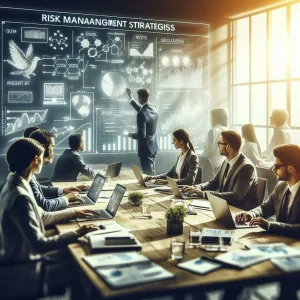In today’s digital age, where organizations heavily rely on technology, cybersecurity has become a cornerstone of risk management. As internal auditors, understanding the significance of cybersecurity audits, especially when aiming to obtain a cybersecurity audit certificate, is crucial for mitigating risks associated with cyber threats. A cybersecurity audit systematically examines an organization’s information security controls to identify vulnerabilities, assess risks, and ensure compliance with regulatory requirements [1].
Why Cybersecurity Audits Matter
Cybersecurity audits are essential due to the growing threats and vulnerabilities in modern organizations. Cyber attacks are increasingly sophisticated, and their impact can be devastating. A single data breach can lead to significant financial losses, reputational damage, and erosion of customer trust. Moreover, insider threats pose a significant risk, accounting for a substantial percentage of security incidents.
As internal auditors, adopting a proactive approach through regular cybersecurity audits is vital to identify and address vulnerabilities before they can be exploited. A cybersecurity audit certificate equips professionals with the necessary skills to assess an organization’s cybersecurity posture effectively [2].
The Challenges with Traditional Audit Approach
The traditional audit approach has been a cornerstone of internal auditing for decades. However, as cybersecurity threats evolve, this approach has become insufficient.
Limitations of Traditional Audit Methods
- Inability to Detect Real-Time Threats: Traditional audits often rely on periodic reviews, missing incidents as they occur.
- Insufficient Visibility: Limited access to network activity can hinder the identification of vulnerabilities.
- Reactive Focus: Traditional methods emphasize responding to breaches rather than preventing them.
To combat these challenges, internal auditors must adapt to the evolving cybersecurity landscape by adopting more proactive approaches, such as continuous monitoring and threat intelligence gathering [3].
What is Continuous Monitoring in Cybersecurity Audit?
Continuous monitoring (covered in detail in cybersecurity audit certificate) is an essential component of modern cybersecurity audit practices. It involves real-time threat detection and incident response, enabling organizations to stay ahead of potential threats.
Benefits of Continuous Monitoring
- Real-Time Threat Detection: Systems are constantly monitored for unauthorized activity, allowing for immediate response.
- Proactive Identification of Security Weaknesses: Continuous assessments help prioritize remediation efforts.
- Enhanced Visibility: Provides real-time insights into security controls, enabling data-driven decisions.
Implementing continuous monitoring is crucial for organizations aiming to maintain a robust cybersecurity posture in today’s threat landscape [4].
Benefits of Continuous Monitoring in Cybersecurity Audit
Adopting continuous monitoring (also covered thoroughly in cybersecurity audit certificates) in cybersecurity audit processes offers numerous advantages:
- Early Detection: Identify and prevent security threats before they escalate.
- Improved Incident Response: Rapid response to threats minimizes downtime and impact.
- Enhanced Compliance: Continuous monitoring helps meet regulatory requirements effectively.
To implement continuous monitoring successfully, organizations must invest in the right tools and develop a comprehensive monitoring strategy that aligns with their risk profile.
Implementing Continuous Monitoring: Best Practices for Internal Auditors
To establish a successful continuous monitoring program, internal auditors should:
- Identify the Right Tools: Evaluate software solutions that provide real-time monitoring capabilities.
- Establish Clear Policies: Define objectives, KPIs, and monitoring frequency.
- Integrate with Audit Frameworks: Align continuous monitoring with existing risk-based auditing approaches.
Key Best Practices
- Align monitoring efforts with business objectives.
- Focus on high-risk areas for monitoring.
- Continuously assess and refine monitoring policies and tools.
- Communicate effectively with stakeholders about monitoring results.
Earning Your Cybersecurity Audit Certificate: Why It Matters
Obtaining a cybersecurity audit certificate is vital for internal auditors. It demonstrates expertise in cybersecurity audit and risk management, enhancing credibility and career prospects [5].
Benefits of a Cybersecurity Audit Certificate
- Demonstrated Expertise: Showcases your ability to assess and mitigate cybersecurity risks.
- Enhanced Credibility: Differentiates you in a competitive job market.
- Improved Career Prospects: Positions you for leadership roles and increased earning potential.
Key Takeaways
- Continuous monitoring is essential for effective cybersecurity audits.
- Proactive approaches can significantly enhance an organization’s security posture.
- Earning a cybersecurity audit certificate can elevate your career and professional reputation.
FAQ: Continuous Monitoring and Cybersecurity Audits
Q: What is the primary goal of continuous monitoring?
A: The primary goal is to provide real-time insights into security controls and quickly identify potential threats.
Q: How can continuous monitoring improve compliance?
A: By ensuring ongoing assessment of security controls, organizations can better meet regulatory requirements.
Conclusion: Taking Your Cybersecurity Audit Game to the Next Level
In conclusion, continuous monitoring is not just a best practice; it is a necessity for internal auditors aiming to protect their organizations from evolving cyber threats. By adopting continuous monitoring, internal auditors can enhance their effectiveness in identifying and mitigating risks, ensuring long-term organizational success [6].
As you move forward, prioritize continuous monitoring in your cybersecurity audit practices, stay informed about industry developments, and collaborate with stakeholders to implement effective strategies. By doing so, you will elevate your cybersecurity audit game and contribute significantly to your organization’s resilience against cyber threats.
Find out more about Shaun Stoltz https://www.shaunstoltz.com/about/
This post was written by an AI and reviewed/edited by a human.



